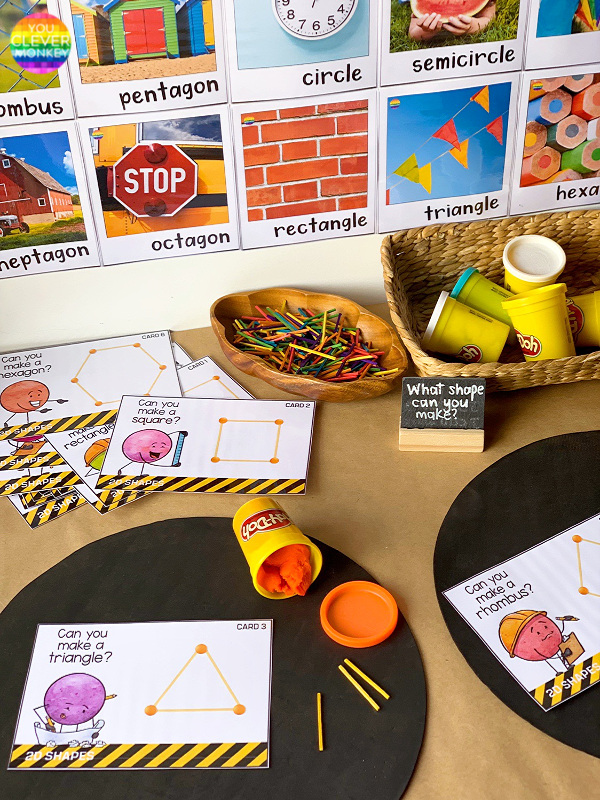Are you looking for lessons and activity ideas that are fun and build a strong understanding of shapes and geometry? Recreate these simple STEM invitations in your classroom to help children learn about 2D shapes and their attributes through play.
The first stage in learning about geometry is being able to identify, name, and describe 2-dimensional shapes. Talking about shapes whenever you see them and having shape posters on the wall are helpful to children as are having plenty of different shape manipulatives available.
Learning about shapes through play and exploration is also key for developing spatial skills in preschool and kindergarten. With careful thought given when choosing materials and prompts, math centers can also help children develop their ability to problem solve and reason while building their fine motor skills and strength and their ability to manage themselves and others cooperatively to complete a task.
Learning about shapes through play and exploration is also key for developing spatial skills in preschool and kindergarten. With careful thought given when choosing materials and prompts, math centers can also help children develop their ability to problem solve and reason while building their fine motor skills and strength and their ability to manage themselves and others cooperatively to complete a task.
We've put together this list of STEM challenges that use simple materials so you can easily create a STEM center or Makerspace children will have an awesome time at building 2D shapes while learning.
This post contains affiliate links.
These 2D Shape STEM Challenge cards are a great place to start exploring 2D shapes as you probably already have these materials in your classroom or at home.
Just choose between the two sets of cards, press print and then add playdough and toothpicks to try and build the different structures.
Always a popular addition to our math centres or STEM tubs, these 2D Shape Pattern Block STEM Challenge Cards make differentiation easy!
With three different types of cards to work between, you just need some pattern blocks to start.
These cards are perfect for learning how to transform shapes to make them fit to the picture and compose new shapes from smaller shapes - that 6 equilateral triangles can make a hexagon.
This is another simple invitation to create and one that is sure to prompt some interesting discussions in your classroom.
You just need to make some magnetic popsticks if you want children to work on a vertical surface but they can just as easily do this on a desktop or floor.
Use some 2D shape posters along with a question 'What shape can you make?' as your prompt.
The children will learn that they can't make every shape with the materials provided.
They can make a square easily, a hexagon is a little tricky but they can't make a circle or oval.
'Why not?' you might prompt.
'Because they have curved lines and I only have straight sticks'
And through such a simple invitation they have been able to use their knowledge of the different shapes and their attributes to reason why they can make some shapes but not others.
Another similar invitation to try is this one - GeoStix + simple shape mats.
GeoStix are perfect for exploring shapes, letters, measurement and angles with older children. Unlike the shape invitation above, GeoStix have lots of different length and shaped sticks so children can make circles, hexagons, kites, anything really making them ideal for preschool and kindergarten aged children making 2D shapes.
When introducing either concepts or materials, keep your invitations simple so children can explore them thoroughly before being asked to move on.
After teaching the basic shapes, this invitation was added to our math centres which asks children to make the different shapes using playdough and toothpicks.
A week or so later, I then swapped these cards with the shapes acting as visual support out for the version that only provide the child with the name of the shape and the number of toothpicks and balls of playdough they need to build with.
Later in the unit, you might create a more open ended invitation like this one in our maker space asking children to build 2D and 3D shapes from a range of different materials and manipulatives.
They might use playdough to make a sphere, sticks for a triangle, string for a circle, blocks for a cube... And when asked children should be able to explain their choices.
Using an invitation such as this can provide children with an opportunity to show what they know in new ways demonstrating problem solving skills, reasoning and spatial skills as they manipulate the materials to make each model something using a worksheet alone can not do.












